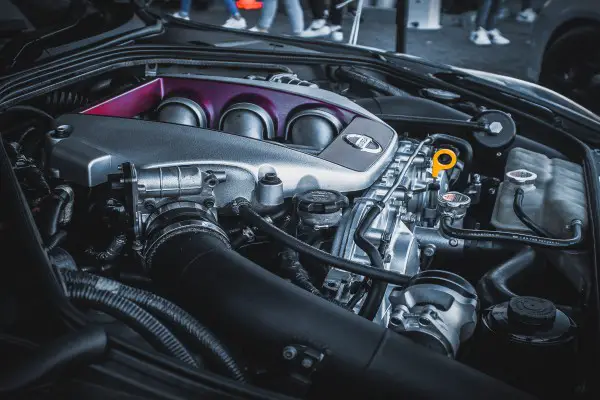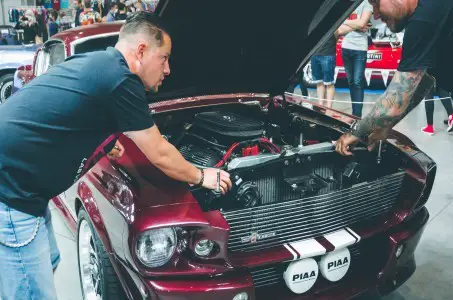Overheating of cars is a frequent, yet possibly dangerous, problem that many drivers face when driving. The unexpected increase in engine temperature can be unsettling and annoying whether you’re driving down the motorway or stopped in stop-and-go traffic. Every car owner must be aware of the causes and effects of their vehicle’s overheating. This essay explores the exhilarating experience of an automobile overheating, from the first warning indications to the eventual return to normalcy. By delving into the causes of overheating accidents and talking about preventive measures, we hope to arm drivers with the information they need to deal with this problem and protect their cars from overheating in the future.
The significance of addressing overheating promptly:
It is imperative that automotive overheating be addressed as soon as possible. Here are a few main justifications:
- Prevents Costly Damage: The operating temperature range for an automobile’s engine is specified. In addition to the head gasket, cylinder head, and piston rings, overheating can seriously harm other engine parts. The cost of replacing or repairing these components may increase.
- Avoids Safety Hazards: Fires, steam, and smoke can result from an overheated engine. This puts the passengers and other drivers on the road in danger in addition to the car.

- Prevents Stranding: An automobile may need to be pulled over and stopped right away if it overheats while being driven. This may result in an abrupt halt on the road, which could result in collisions or leave the people trapped in a dangerous area.
- Preserve Engine Efficiency: Engine efficiency can be harmed by overheating, which can result in poor performance overall, increased fuel consumption, and decreased power.
- Preserve Vehicle Longevity: A vehicle’s lifespan can be considerably shortened by persistent overheating. An individual can guarantee the safe and effective operation of their car and prolong its lifespan by swiftly treating overheating and determining its underlying cause.
- Maintains Resale Value: A well-kept vehicle with no history of overheating is more valuable when sold. Conversely, a car with a history of overheating problems can be less valuable to buy because of the possibility of undiscovered damage.
The Overheating Episode:
One dangerous situation that might occur when operating a vehicle is an overheating episode, which frequently alarms the driver and other passengers. The following describes what usually occurs during an episode of overheating:
- Warning Signs: The temperature gauge in the car begins to rise, a sign that the engine is overheating. Steam coming from the hood, a burning smell, or the dashboard’s engine overheating warning light turning on could all be signs of this. These indicators point to a malfunctioning cooling system in the engine.
- Response: The driver needs to take immediate action to stop additional damage after observing these warning indications. This usually entails stopping as soon as you can at a safe place. Serious damage may result from continuing to drive an overheating engine.
- Immediate Steps: The driver needs to stop the engine, turn it off, and let it cool. It might take a few minutes to complete. It’s best to wait until it’s safe to do so rather than opening the hood to help dissipate heat if the engine is really hot.
- Cooling Down: The temperature gauge ought to stabilize as the engine cools, and any engine-related smoke or steam should start to disappear. You must avoid opening the radiator cap or adding coolant during this period as it may still be under pressure and result in burns.
- Investigation: The driver can check the coolant level in the radiator or overflow tank (if it’s safe to do so) after the engine has cooled. Before you drive the car again, you should fix any leaks that may have been caused by a low coolant level.
- Seeking Assistance: It’s critical to ask for roadside help or a tow truck if the driver is unsure of the source of the overheating or does not feel comfortable assessing the car themselves. To guarantee that the vehicle is safe to drive, a qualified mechanic can identify the problem and carry out the required repairs.
The Return to Normalcy from overheating:
Before resuming driving after an overheating incident, make sure the vehicle is back in normal operating condition. What usually occurs when the car gets back to normal is as follows:
- Cool Down Period: The car starts to cool down when the engine is shut off. Depending on how hot the engine became and the outside temperature, this cooling procedure could take a few minutes to many hours.
- Temperature Gauge: The dashboard temperature gauge is one of the first indicators that the vehicle is getting back to normal. It ought to return gradually to its typical functioning range.
- Steam or Smoke: As the engine cools, any steam or smoke that may have been emanating from it should likewise disappear. It’s important to remember, though, that some mild steam or smoke may be expected, particularly when the engine is running hot on chilly days.
- Coolant Levels: The driver can check the coolant level once the engine has cooled down enough to allow for a safe opening of the hood. Now that the engine has cooled, it might be required to add more coolant if it was low before the overheating incident.
- Safety Checks: Making sure the car is safe to drive is crucial before getting behind the wheel again. This entails ensuring the lights, tires, brakes, and other crucial systems are all operating properly.

Common Causes of Car Overheating:
Many problems can lead to a car overheating, therefore it’s critical to find the underlying cause to stop such occurrences in the future. The following are some typical reasons why cars overheat:
- Low Coolant Level: Low coolant concentrations can cause overheating. Low coolant levels prevent the engine from efficiently dissipating heat, which is why coolant is essential to controlling engine temperature.
- Faulty Thermostat: The engine’s coolant flow is controlled by the thermostat. It will not circulate coolant adequately if it is stuck closed, which will cause overheating.
- Coolant Leaks: Overheating can result from coolant loss brought on by cooling system leaks. Leaks are frequently found in the water pump, head gasket, hoses, and radiator.
- Malfunctioning Water Pump: The engine’s coolant is distributed throughout it via the water pump. Overheating will result from coolant not flowing if it fails.
- Blocked Radiator: Heat dissipation from the radiator may be hindered by obstructions caused by dirt, debris, or corrosion.
- Cooling Fan Malfunction: When the car is at rest or traveling slowly, the cooling fan aids in the dissipation of heat. An engine that isn’t operating properly may overheat.
- Faulty Radiator Cap: The cooling system’s pressure is preserved by the radiator cap. Overheating may result from coolant boiling over if it’s not sealing correctly.
- Engine Oil Issues: The engine may overheat as a result of increased friction and heat generation from low or dirty engine oil.
- Failed Head Gasket: Overheating may result from a blown head gasket allowing coolant to seep into the crankcase or combustion chamber.
- Air in the Cooling System: Overheating may result from coolant that isn’t circulating correctly due to air pockets.
- Overheating Conditions: Overheating can result from extreme weather conditions that put stress on the cooling system, such as high temperatures or heavy loads.
- Exhaust System Restrictions: The engine may overheat if the exhaust system or catalytic converter are clogged.
- Engine Misfire: Overheating may result from an engine that isn’t operating properly producing more heat.
- Coolant System Bleeding Issues: Overheating might result from improperly bleeding the cooling system after maintenance, which creates air pockets.
- Coolant Mixture Issues: The efficiency of the cooling system may be impacted by using the incorrect coolant or having the coolant-to-water ratio.
Solutions and Preventive Measures:
Here are some solutions and preventive measures to help prevent car overheating:
- Regular Maintenance: It is essential to do routine maintenance to avoid overheating problems. This includes monitoring the cooling system for leaks, making sure the thermostat is operating properly, refilling the coolant as necessary, and assessing the radiator and water pump’s state.
- Coolant System Flushing: Any accumulation or impurities that may be preventing the coolant system from functioning properly can be removed with regular flushing.
- Proper Coolant Mixture: For best results, use the right kind of coolant for your car and the proper ratio of coolant to water.
- Check the Radiator Cap: Verify that the radiator cap is correctly sealed and in good shape. Overheating may result from coolant boiling over due to a malfunctioning cap.
- Cooling Fan Maintenance: Verify that the cooling fan is operating properly. When the air conditioner is functioning or the engine reaches a particular temperature, it should activate.
- Check for Coolant Leaks: Check the cooling system regularly for leaks in the head gasket, water pump, hoses, and radiator.
- Avoid Overloading: Steer clear of overloading the car or pulling big objects, as these actions might strain the cooling system and engine even more.
- Drive Responsibly: Avoid driving aggressively as this might raise the engine’s temperature and cause overheating, especially in warm weather.
- Monitor Temperature Gauge: Keep an eye on the dashboard’s temperature gauge. To avoid overheating, stop and turn off the engine if it begins to climb.
- Avoid Overheating Conditions: Use the air conditioner only when necessary in hot weather, and don’t leave it on all the time as this will strain the cooling system even more.
- Replace Worn or Damaged Parts: To avoid overheating, get any worn-out or damaged cooling system parts, such as the radiator, water pump, or hoses, replaced right away.
Frequently asked questions:
Can an overheated automobile recover?
If the engine is let to cool down and the underlying problems that led to the overheating are fixed, an overheated car can recover.
What is causing my car to repeatedly overheat?
Among other things, a broken water pump, a leaking head gasket, or a defective thermostat could be the reason why your automobile overheats frequently.
When an engine overheats, is it still salvageable?
It is possible to recover an overheated engine, but the cost and labor of the repair will depend on the severity of the damage and how quickly it is done.
Is overheating possible with low oil?
Low oil levels can cause the engine to overheat by increasing friction and internal heat.
Conclusion:
To sum up, although automotive overheating can be a deadly and serious problem, it can also be avoided in many cases with regular maintenance and careful attention to detail. Frequent examinations of the coolant levels, radiator health, thermostat, and water pump can aid in spotting such concerns early on and addressing them before they worsen. Additionally, it’s critical to recognize the early warning indicators of overheating, which include rising temperature readings, steam, and strange smells, and to respond quickly if any of these occur. Drivers may contribute to ensuring that their cars stay safe, dependable, and free from overheating problems by following these guidelines and practicing proactive car maintenance.

